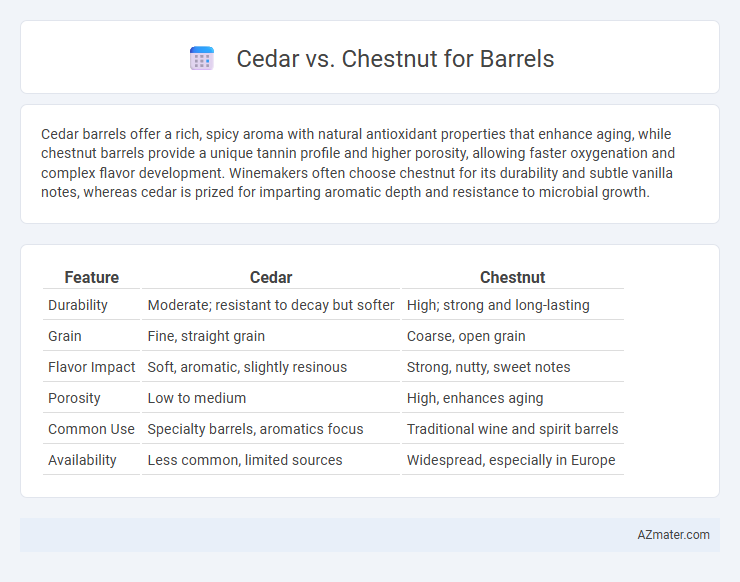Cedar barrels offer a rich, spicy aroma with natural antioxidant properties that enhance aging, while chestnut barrels provide a unique tannin profile and higher porosity, allowing faster oxygenation and complex flavor development. Winemakers often choose chestnut for its durability and subtle vanilla notes, whereas cedar is prized for imparting aromatic depth and resistance to microbial growth.
Table of Comparison
| Feature | Cedar | Chestnut |
|---|---|---|
| Durability | Moderate; resistant to decay but softer | High; strong and long-lasting |
| Grain | Fine, straight grain | Coarse, open grain |
| Flavor Impact | Soft, aromatic, slightly resinous | Strong, nutty, sweet notes |
| Porosity | Low to medium | High, enhances aging |
| Common Use | Specialty barrels, aromatics focus | Traditional wine and spirit barrels |
| Availability | Less common, limited sources | Widespread, especially in Europe |
Introduction to Cedar and Chestnut Barrels
Cedar and chestnut barrels are prized in aging spirits and wines for their distinct wood properties and impact on flavor profiles. Cedar barrels offer a unique aromatic complexity, often adding spicy and resinous notes, while chestnut barrels are valued for their high tannin content and oxygen permeability, enhancing the maturation process. Both types contribute to the beverage's character, with chestnut promoting smoothness and cedar imparting subtle herbal nuances.
Wood Characteristics: Cedar vs. Chestnut
Cedar wood is renowned for its aromatic qualities, lightweight structure, and natural resistance to decay, making it ideal for barrels requiring enhanced fragrance and longevity. Chestnut wood offers a dense, porous texture that allows for excellent oxygen permeability, contributing to complex flavor development and optimal aging in barrel maturation. Both woods provide unique tannin profiles, with cedar imparting subtle spice notes and chestnut delivering robust, nutty undertones essential for wine and spirit refinement.
Aroma and Flavor Impact on Aged Beverages
Cedar barrels impart distinctive aromatic notes of spice, resin, and subtle sweetness that enhance the complexity and warmth of aged beverages, while chestnut barrels contribute earthy, nutty, and slightly tannic flavors that deepen the drink's structure and mouthfeel. The porous nature of chestnut wood allows for moderate oxygen exchange, promoting smoother maturation and richer flavor development, whereas cedar's tighter grain results in more pronounced aromatic intensity without overwhelming the palate. Choosing between cedar and chestnut barrels significantly influences the sensory profile of spirits and wines, tailoring aroma and flavor outcomes according to aging goals.
Barrel Construction Differences
Cedar barrels are known for their tight grain and natural oils, providing excellent moisture resistance but requiring careful seasoning to avoid excessive tannin extraction. Chestnut barrels offer a looser grain structure, allowing greater oxygen permeability which enhances micro-oxidation and flavor complexity in aging spirits. The fundamental construction difference lies in chestnut's porous texture that facilitates slow oxygen exchange, compared to cedar's denser wood that emphasizes aromatic retention and durability.
Durability and Longevity Comparison
Cedar barrels exhibit moderate durability with natural resistance to moisture and decay, making them suitable for aging spirits over several years. Chestnut barrels offer superior longevity due to their dense grain structure and high tannin content, which enhance resistance to wear and microbial degradation. Compared to cedar, chestnut barrels generally provide longer service life and better durability in aging environments.
Suitability for Wine, Whiskey, and Other Spirits
Cedar barrels impart a distinct aromatic profile with herbal and spicy notes, making them suitable for aging certain red wines and whiskey varieties that benefit from enhanced complexity and subtle resinous flavors. Chestnut barrels offer excellent oxygen permeability, promoting smooth maturation and fruity character development, widely favored in traditional European wine and spirit production, especially for brandy and fortified wines. Both woods differ in tannin levels and interaction with spirits, where cedar's moderate tannins complement robust aging styles, while chestnut's higher tannins and porous structure accelerate aging, ideal for faster maturation without overwhelming the base spirit.
Environmental and Sustainability Considerations
Cedar barrels are often sourced from slower-growing trees, raising concerns about deforestation and carbon sequestration compared to chestnut, which typically grows faster and supports more sustainable forestry practices. Chestnut barrels have a lower environmental footprint due to their higher yield per hectare and better adaptability to reforestation efforts, promoting biodiversity in managed woodlands. The biodegradability and lower chemical treatment requirements of chestnut wood also contribute to more eco-friendly barrel production.
Cost and Availability of Cedar and Chestnut
Chestnut barrels are generally more affordable than cedar barrels due to the greater abundance of chestnut wood in European forests, especially in Mediterranean regions. Cedar barrels are typically costlier because cedar wood is less common, often sourced from limited regions, and requires more processing to achieve barrel standards. Availability of chestnut barrels is higher, supporting larger-scale production, whereas cedar barrels are less accessible and often reserved for niche products or premium aging.
Popular Uses in Global Spirits Production
Chestnut barrels are widely favored in European spirits production, particularly for aging brandies such as Cognac and Armagnac, due to their tannin content which enhances flavor complexity and smoothness. Cedar barrels, less common in mainstream spirits, are prized in certain niche markets for aging whisky and mezcal, imparting unique aromatic profiles characterized by resinous and spicy notes. The distinct grain structure and chemical composition of chestnut promote faster maturation, while cedar's natural oils contribute to distinctive sensory qualities sought after in artisanal craft spirits.
Choosing the Right Wood: Cedar or Chestnut?
Choosing between cedar and chestnut for barrel construction hinges on the desired aging characteristics and flavor profiles in winemaking or spirits. Cedar offers a tight grain that imparts subtle aromatic notes and improved oxygen exchange, while chestnut provides a coarser texture contributing to more intense tannins and enhanced wood complexity. Durability and moisture resistance also favor chestnut, making it a popular option in traditional European cooperage.

Infographic: Cedar vs Chestnut for Barrel
 azmater.com
azmater.com